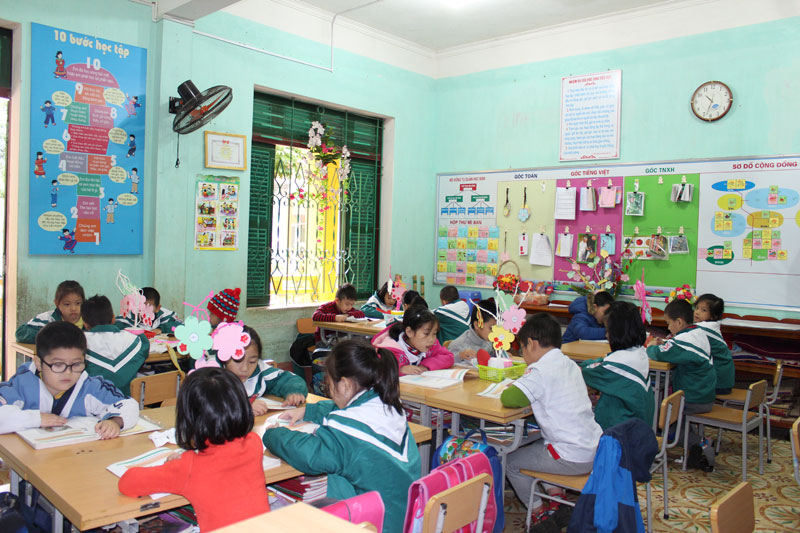
(HBO) – Being a province with 70% population of ethnic minority people, Hoa Binh Department of Education and Training pays special attention to teach Vietnamese and ethnic minority languages.
A Vietnamese lesson of pupils at Mai Chau Town Primary School (Mai Chau).
Mr. Nguyen Duc Luong, The Deputy Director of Education and Training Department confirmed: To continue implementing the Instruction No. 38 on November 29th, 2004 of Prime Minister about strengthening training and fostering ethnic minority languages, the Department has guided all the general education institutions and vocational training centers to organize classes, assessing and giving certificates of ethnic minority languages. In the school year of 2016-2017, The Department of Education and Training organized clases, assessed and gave certificates of Mong and Thai ethnic languages for 213 staffs, officials and teachers in the province area. This helps staffs, officials and teachers become more active and confident in their work at the ethnic minority area.
Especially, on September 8th, 2016, the provincial People’s Committee announced the Decision No. 2295/QD –UBND about approving Muong ethnic letter system in Hoa Binh. This means that the Muong letter system includes 28 letters, 24 first consonants, 1 accompanied sound. To make Muong ethnic language popular in the social life, on October 27th, 2016, the provincial People’s Committee promulgated the Plan No. 118 to exploit the application of Muong ethnic letter system in Hoa Binh province. One of the most typical features of this plan is to design a textbook of learning Muong language which was approved by the authorized office, then organize teaching and learning Muong ethnic language for all people levels in the province. Based on the provincial plans, the Department of Education and Training guided the staffs, officials and teachers in all units and schools to strengthen self-study, foster ethnic minority languages. All the units and schools connect the content of self –studying and fostering the ethnic minority languages closely with fostering regularly for staffs and teachers. All the staffs and teachers have set up plans for self- studying, self- fostering ethnic minority for their teaching and communication with pupils’ parents.
Together with teaching ethnic minority languages, the Department of Education and Training has taken care of teaching Vietnamese for ethnic minority pupils. It has continuously strengthened to implement content of Vietnamese preparation and Vietnamese strengthening for ethnic minority pupils (kindergartens, primary schools) which is relevant to the local situation. On March 10th, 2017, the Department of Education and Training issued the Documentary No. 573 about "Strengthening Vietnamese for ethnic minority children at kindergartens”. For Grade 1 of Ethnic Minority, strengthen Vietnamese in the direction of Ministry of Education and Training”.
The Department has well implemented teaching Vietnamese for ethnic minority pupils in the direction of increasing the amount of learning Vietnamese time by learning 2 lessons/ day or have an extra lesson/ week. 100% schools have organized Vietnamese preparation course for children before Grade 1 (in the summer fostering course). Besides, schools held extra 1-2 Vietnamese classes for children every week, which contributes to improve the general education quality and national education quality.
Especially, the provincial Department has directed all the schools, especially the schools of Hang Kia commune, Pa Co commune of Mai Chau district (with 100% population of Mong people) strengthen the time of teaching Vietnamese for ethnic minority children in the integrating way into school subjects, extra outdoor activities. Schools and teachers usually collaborate with communities and parents to create communicating environment of Vietnamese for ethnic pupils. It really increases the education quality, and cultural knowledge in ethnic minority area.
At HANOI JVC Training Center (Hanoi), the Farmers’s Support Center, the Provincial Farmers' Union and VTC1 International Development joint Stock Company recently held a signing ceremony for a cooperation agreement to link consulting and create the labor resources working abroad for a limited period of time.
In recent years, the education career in Yen Thuy district has changed positively. The school facilities have newly been built and the quality of education has improved.
The Board for Women's Advancement of Hoa Binh province on November 11 officially launched the Action Month for Gender Equality, focusing on preventing and addressing gender-based violence. As part of the event, a special talk was held on the theme of sharing household work for a happy family. The event drew 300 delegates, including Nguyen Van Toan, Standing Vice Chairman of the provincial People's Committee and head of the provincial Board for Women's Advancement.
The people in Hoa Binh province are aware of the need to build and preserve the cultural traditions and unique customs of their communities, especially those related to ethnic identities and family values which serve as foundation for a vibrant, tradition-rich Hoa Binh, enriching community life. In recent years, the province’s Party Committee, authorities, and residents have paid heed to building and developing family values and fostering human standards in the new era.
The festival of great national solidarity and culture in 2024 was held at the communal house of Da Bac district on November 5. Vice Chairman of the provincial People’s Committee Nguyen Van Toan and leaders of departments and sectors attended the event.
The Labor Federation of Da Bac district has focused on protecting workers' rights while actively participating in patriotic emulation movements to enhance the creativity and productivity of the local workforces across agencies, organisations and enterprises.



